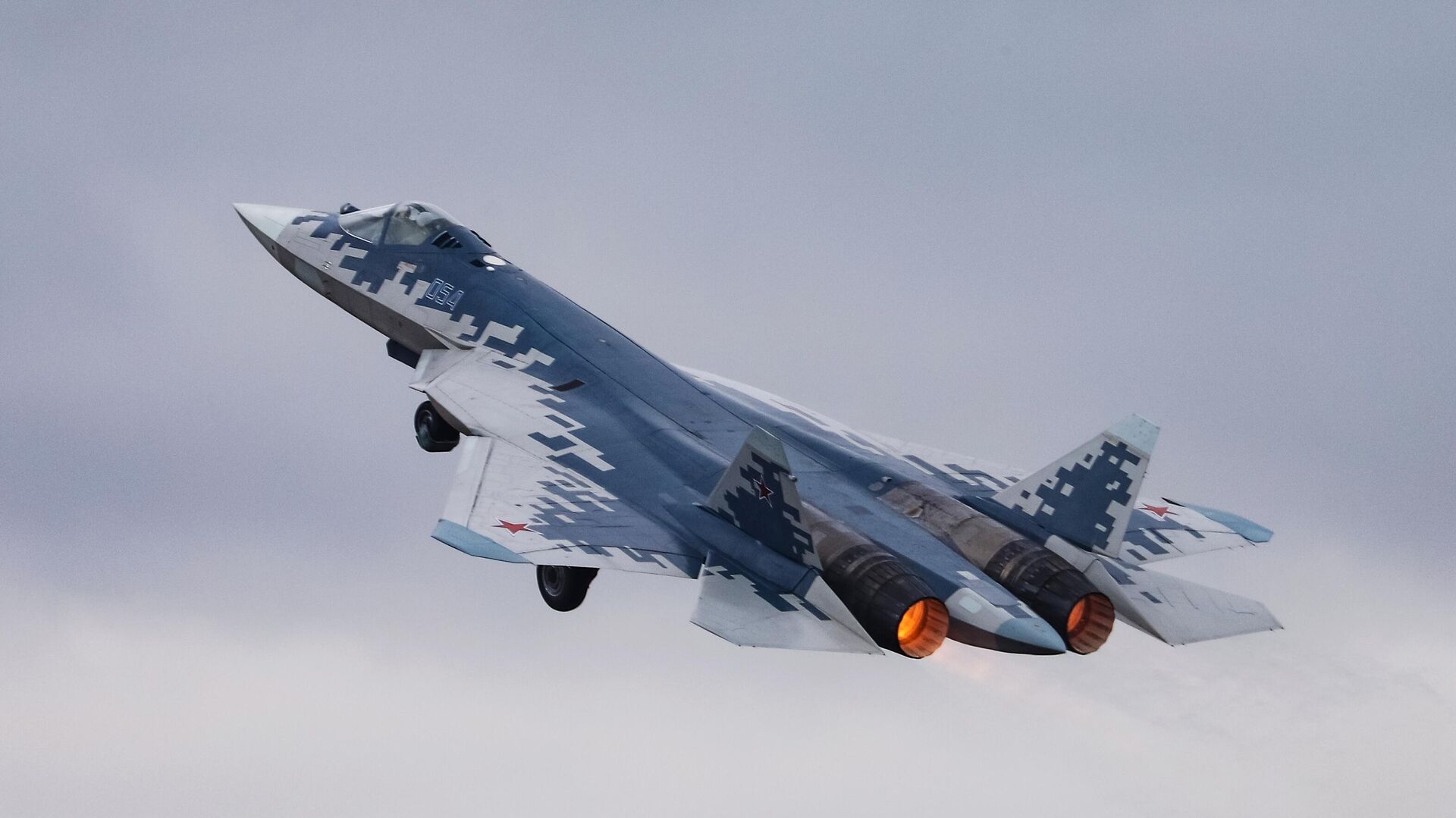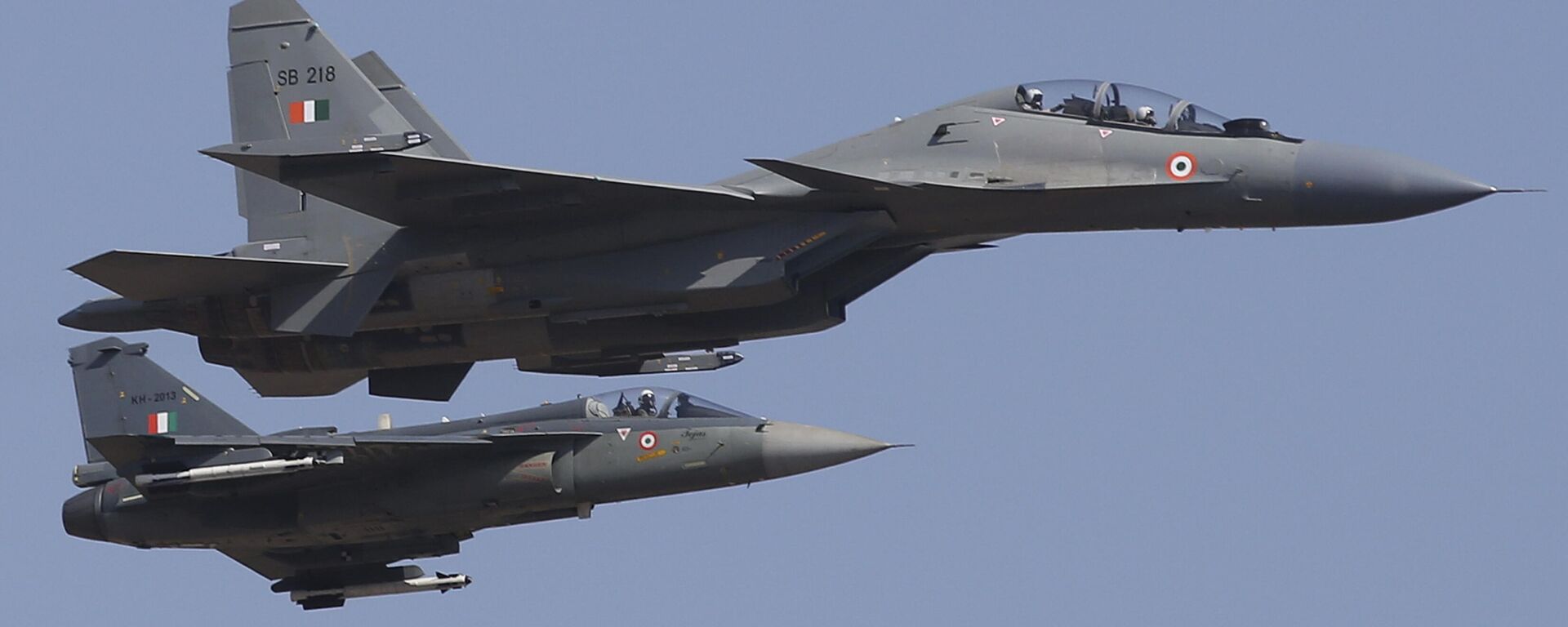https://sputniknews.in/20250311/can-worlds-most-advanced-russian-engine-trump-us-in-high-stakes-indian-deal-8852146.html
Can 'World's Most Advanced' Russian Engine Trump US in High-Stakes Indian Deal?
Can 'World's Most Advanced' Russian Engine Trump US in High-Stakes Indian Deal?
Sputnik India
Four military-industrial giants—France's Safran, the UK's Rolls-Royce, America's General Electric, and Russia's UEC—are vying for a multi-billion dollar... 11.03.2025, Sputnik India
2025-03-11T16:28+0530
2025-03-11T16:28+0530
2025-03-11T17:28+0530
russia
india
us
indian air force (iaf)
sukhoi su-30mki
hindustan aeronautics limited (hal)
su-57 fighter
su-57e
moscow
delhi
https://cdn1.img.sputniknews.in/img/07e9/02/06/8743137_0:0:3145:1769_1920x0_80_0_0_412b033b9fdf2d557b054c34d5e88469.jpg
Russia is offering India the most technologically advanced warplane engine in the world with no political strings attached to the deal, while the United States remains an unreliable partner because it tends to play ball during the time of a crisis, experts have told Sputnik India.Russia's United Engine Corporation (UEC) is now not only capable of recreating engines that were previously produced, but can also modify them to enhance their tactical and technical characteristics, and is creating entirely new engines. This includes turboprop, turbojet engines, and even rocket engines, according to Alexey Leonkov, a military analyst and editor of Arsenal Otechestva (Arsenal of the Fatherland).A powerful scientific and technical base has been developed, which is used to create advanced engines that meet the requirements of international certification bodies like the International Civil Aviation Organisation (ICAO) for both civil and military aircraft engines and Russia has managed to overcome the crisis of the 1990s when the development and construction of new engines almost ceased entirely, he noted.If India chooses to collaborate with Russia, it will benefit from a robust, crisis-resistant scientific, technical, and production infrastructure, he said. This partnership will offer the opportunity to partially localise engine production on Indian soil through the Make in India initiative, along with the technical expertise for the operation and maintenance of these engines, or those jointly produced by Russia and India, the defence analyst emphasised.When comparing Russian, British, and American engine manufacturing, it's clear that many engines in series production in the UK and the US are based on a core engine, with modifications mainly involving changes to the combustion chamber, turbine blades, and similar adjustments, Leonkov highlighted.This suggests that the production and supply of engine components, as well as the operational reliability of these engines, are not in optimal condition, he said. Previously, British and American aircraft engines were considered paragons of reliability, efficiency, and low operational costs, but over the last fifteen years, this trend has shifted as operating costs have risen, the engines' technical characteristics have deteriorated, and the number of engine-related incidents has increased, the aviation pundit stated.This may be due, in part, to the outsourcing of many engine components. For example, Pratt & Whitney engines are assembled from parts manufactured all over the world, including in Turkiye, Europe, Mexico, and the United States. This global outsourcing can sometimes lead to compatibility issues between parts, resulting in operational failures and, in some cases, crashes, he explained.France once produced engines in collaboration with Russia, notably the SaM146, used in the Superjet. But the combustion chambers of these engines had a low operational lifespan, requiring frequent replacements after just a few hundred flying hours, Leonkov mentioned.Following France's exit from engine production after 2022, Russia turned to domestic alternatives, such as the PD-8, which not only meet Russia's safety and operational requirements but also have a significantly higher lifespan before the first overhaul compared to their French counterparts, the military commentator argued.If India enters into this collaboration, it will be a wise decision, as their competitors, such as China, have struggled for 40 years to develop their own engine production base, the expert suggested.Creating a new engine involves not just design but advanced technologies. Russia is now employing additive technologies in many of its engine components, where the parts are more durable and technically superior compared to those made using traditional methods, Leonkov asserted.There are two key points that suggest Russia is indeed a strong contender to win this race for proposals, and that the Russian offer is highly attractive to the Indian partner, as well as to many other potential partners, Oleg Panteleev, the Executive Director of the AviaPort agency, stated.The second point concerns the level of cooperation that Russia can offer, which is unprecedented. This means that India's dependence on the political mood in Russia will be minimal, and the volume of technology transferred to Indian partners will be maximised, he opined.This will enable India, first, to develop many advanced technologies at its own enterprises, and, second, to safeguard its interests in a fluctuating geopolitical environment. One shouldn't forget that how easily former Western partners literally cut off entire countries from the promised and paid-for services in the past, Panteleev elaborated.India is in desperate need of a state-of-the-art fighter jet engine, especially for its Tejas Mark-2 and Advanced Medium Combat Aircraft (AMCA), the country's maiden 5.5 generation combat plane, retired Group Captain Uttam Kumar Devnath reiterated.India is looking at an engine in the 110 kilo-newton+ category to power its indigenous Tejas fighters as well as the futuristic AMCA, something not many nations can provide. Nonetheless, Russia, the US, UK, and France are among the four sovereign states that have shown their willingness to partner with India, he expressed.Russia is already helping Hindustan Aeronautics Limited (HAL) with AL-31FP engines that are being fitted into India's fleet of Su-30MKI warplanes. That's why I believe that Russia may propose to sell the AL-51F1, the engine that powers the nation's stealth fighter, Su-57, to India, Devnath concluded.
https://sputniknews.in/20250306/rudram-3-and-su-30mki-indias-airpower-duo-to-give-enemies-sky-high-nightmares-8841282.html
russia
india
us
moscow
delhi
new delhi
Sputnik India
feedback.hindi@sputniknews.com
+74956456601
MIA „Rossiya Segodnya“
2025
Pawan Atri
https://cdn1.img.sputniknews.in/img/07e6/0c/13/139630_147:0:831:684_100x100_80_0_0_8fa2b25903e7787fe6a2698552c167df.png
Pawan Atri
https://cdn1.img.sputniknews.in/img/07e6/0c/13/139630_147:0:831:684_100x100_80_0_0_8fa2b25903e7787fe6a2698552c167df.png
News
en_IN
Sputnik India
feedback.hindi@sputniknews.com
+74956456601
MIA „Rossiya Segodnya“
Sputnik India
feedback.hindi@sputniknews.com
+74956456601
MIA „Rossiya Segodnya“
Pawan Atri
https://cdn1.img.sputniknews.in/img/07e6/0c/13/139630_147:0:831:684_100x100_80_0_0_8fa2b25903e7787fe6a2698552c167df.png
russia, india, us, indian air force (iaf), sukhoi su-30mki, hindustan aeronautics limited (hal), su-57 fighter, su-57e, moscow, delhi, new delhi
russia, india, us, indian air force (iaf), sukhoi su-30mki, hindustan aeronautics limited (hal), su-57 fighter, su-57e, moscow, delhi, new delhi
Can 'World's Most Advanced' Russian Engine Trump US in High-Stakes Indian Deal?
16:28 11.03.2025 (Updated: 17:28 11.03.2025) Four military-industrial giants—France's Safran, the UK's Rolls-Royce, America's General Electric, and Russia's UEC—are vying for a multi-billion dollar contract to supply India with advanced jet engines.
Russia is offering India the most technologically advanced warplane engine in the world with no political strings attached to the deal, while the United States remains an unreliable partner because it tends to play ball during the time of a crisis, experts have told Sputnik India.
Russia's United Engine Corporation (UEC) is now not only capable of recreating engines that were previously produced, but can also modify them to enhance their tactical and technical characteristics, and is creating entirely new engines. This includes turboprop, turbojet engines, and even rocket engines, according to Alexey Leonkov, a military analyst and editor of Arsenal Otechestva (Arsenal of the Fatherland).
A powerful scientific and technical base has been developed, which is used to create advanced engines that meet the requirements of
international certification bodies like the
International Civil Aviation Organisation (ICAO) for both civil and military aircraft engines and Russia has managed to overcome the crisis of the 1990s when the development and construction of new engines almost ceased entirely, he noted.
"Now, all companies within the UEC are manufacturing a full range of engines, both those already in service and those being developed as new serial products. These engines are not only for Russian-made aircraft but can also be adapted for foreign aircraft, including those from manufacturers like Boeing, Embraer, Airbus, or Bombardier," Leonkov underlined.
If India chooses to collaborate with Russia, it will benefit from a robust, crisis-resistant scientific, technical, and production infrastructure, he said. This partnership will offer the opportunity to partially localise engine production on Indian soil through the Make in India initiative, along with the technical expertise for the operation and maintenance of these engines, or those jointly produced by Russia and India, the defence analyst emphasised.
When comparing Russian, British, and American engine manufacturing, it's clear that many engines in series production in the UK and the US are based
on a core engine, with modifications mainly involving changes to the combustion chamber, turbine blades, and similar adjustments, Leonkov highlighted.
"Companies like Pratt & Whitney [US] and Rolls-Royce [UK] primarily produce a basic model from which civil and military versions are derived. However, the production of entirely new engines to meet modern standards has become increasingly rare. Recent aviation incidents involving Boeing show that many of these accidents have been linked to engine failures," the expert underscored.
This suggests that the production and supply of engine components, as well as the operational reliability of these engines, are not in optimal condition, he said. Previously, British and American aircraft engines were considered paragons of reliability, efficiency, and low operational costs, but over the last fifteen years, this trend has shifted as operating costs have risen, the engines' technical characteristics have deteriorated, and the number of engine-related incidents has increased, the aviation pundit stated.
This may be due, in part, to the outsourcing of many engine components. For example, Pratt & Whitney engines are assembled from parts manufactured all over the world, including in Turkiye, Europe, Mexico, and the United States. This global outsourcing can sometimes lead to compatibility issues between parts, resulting
in operational failures and, in some cases, crashes, he explained.
France once produced engines in collaboration with Russia, notably the SaM146, used in the Superjet. But the combustion chambers of these engines had a low operational lifespan, requiring frequent replacements after just a few hundred flying hours, Leonkov mentioned.
Following France's exit from engine production after 2022, Russia turned to domestic alternatives, such as the PD-8, which not only meet Russia's safety and operational requirements but also have a significantly higher lifespan before the first overhaul compared to their French counterparts, the military commentator argued.
"Seventy percent of India's military equipment is sourced through Indian production facilities under Make in India. The same approach could be adopted for civil products, particularly in the field of engine manufacturing, which is currently experiencing growth in Russia," he remarked. "Russia is keen to expand engine production and exports, as this will enhance the country's manufacturing capacity and create future opportunities for developing new engines, such as the PD-35, which is designed for large aircraft, whether cargo-passenger hybrids or entirely passenger models."
If India enters into this collaboration, it will be a wise decision, as their competitors, such as China, have struggled for 40 years to develop their own engine production base, the expert suggested.
Creating a new engine involves not just design but advanced technologies. Russia is now employing additive technologies in many of its engine components, where the parts are more durable and technically superior compared to those made
using traditional methods, Leonkov asserted.
There are two key points that suggest Russia is indeed a strong contender to win this race for proposals, and that the Russian offer is highly attractive to the Indian partner, as well as to many other potential partners, Oleg Panteleev, the Executive Director of the AviaPort agency, stated.
"Russia currently possesses the most advanced engine in terms of technical and technological capabilities, which fully meets the modern and future requirements for equipping tactical aircraft, including fifth-generation aircraft. In other words, it is offering not an outdated product, but one that is at the cutting edge of technological progress," the observer stressed.
The second point concerns the level of cooperation that Russia can offer, which is unprecedented. This means that India's dependence on the political mood in Russia will be minimal, and the volume of technology transferred to Indian partners will be maximised, he opined.
This will enable India, first, to develop many advanced technologies at its own enterprises, and, second, to safeguard its interests in a
fluctuating geopolitical environment. One shouldn't forget that how easily former Western partners literally cut off entire countries from the promised and paid-for services in the past, Panteleev elaborated.
India is in desperate need of a state-of-the-art fighter jet engine, especially for its Tejas Mark-2 and Advanced Medium Combat Aircraft (AMCA), the country's maiden 5.5 generation combat plane, retired Group Captain Uttam Kumar Devnath reiterated.
India is looking at an engine in the 110 kilo-newton+ category to power its indigenous Tejas fighters as well as the futuristic AMCA, something not many nations can provide. Nonetheless, Russia, the US, UK, and France are among the four sovereign states that have shown their willingness to partner with India, he expressed.
"In fact, such type of engines has been offered by America's GE. But the reliability and continuity of supply of these vital military systems is extremely doubtful as India has seen till now. As a result, India would be keen to acquire advanced fighter jet engines from Russia because the country definitely would not like to gain political mileage out of it. Besides, the Russians would willingly agree to a transfer of technology," the Indian Air Force (IAF) veteran commented.
Russia is already helping Hindustan Aeronautics Limited (HAL) with AL-31FP engines that are being fitted into India's fleet of Su-30MKI warplanes. That's why I believe that Russia may propose to sell the AL-51F1, the engine that powers the nation's stealth fighter, Su-57, to India, Devnath concluded.



